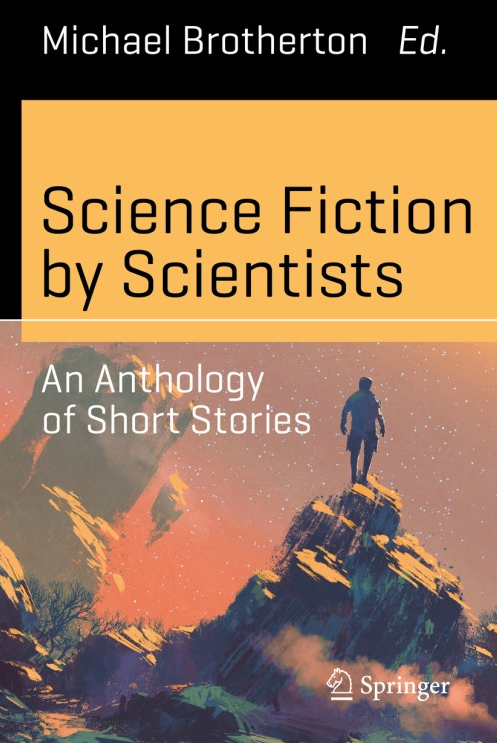Of the grand order of folio leviathans, the Sperm Whale and the Right Whale are by far the most noteworthy. They are the only whales regularly hunted by man. To the Nantucketer, they present the two extremes of all the known varieties of the whale. As the external difference between them is mainly observable in their heads; and as a head of each is this moment hanging from the Pequod's side.

Science Fiction
 Like Carl Sagan, I was inspired to become an astronomer by reading science fiction in my early teens. And I have remained a fan of scientifically reasonable science fiction ever since. I have discussed and recommended science fiction with good astronomy in my classes, have tried to keep up with science-fiction authors whose stories take off from a grounding in good science, and have (more recently) even tried my hand at writing science fiction. On this page, you can find links to some of my science-fiction recommendations, to articles I’ve written, and to my (so far) eight published science fiction stories.
Like Carl Sagan, I was inspired to become an astronomer by reading science fiction in my early teens. And I have remained a fan of scientifically reasonable science fiction ever since. I have discussed and recommended science fiction with good astronomy in my classes, have tried to keep up with science-fiction authors whose stories take off from a grounding in good science, and have (more recently) even tried my hand at writing science fiction. On this page, you can find links to some of my science-fiction recommendations, to articles I’ve written, and to my (so far) eight published science fiction stories.
I keep an on-line list of science fiction stories with good astronomy and physics (organized by topic) at:
http://bit.ly/astronomyscifi
(Note that a number of the recommended stories can be read free on the web and links are provided. Others can be found in anthologies that are sometimes available used on book-selling websites.)
I wrote an article for Nature about science fiction that scientists and science buffs would especially enjoy. You can read it at:
https://www.researchgate.net/publication/307611215_Special_Science_Fiction_for_Scientists
An earlier version appeared in the Astronomical Society of the Pacific’s Astronomy Beat, and can be found at:
https://www.researchgate.net/publication/261364023_Ten_Science_Fiction_Writers_for_Scientists_and_Science_Enthusiasts
More recently, I have begun writing science fiction stories, and, after several years of submissions, eight of my stories have now been published.
- The first, “Cave in Arsia Mons,” is about an unexpected discovery made in a cave on the side of one of the giant volcanoes on Mars. It was published in Building Red: Mission Mars, an anthology edited by Janet Cannon. They have given me permission to make it available free on the web at:
https://www.researchgate.net/publication/282914928_The_Cave_in_Arsia_Mons - The second, “Supernova Rhythm,” combines my interest in exploding stars and classical music, and applies some of the ideas of the Russian composer Alexander Scriabin to an advanced civilization among the stars. It is published in an anthology entitled Science Fiction by Scientists, edited by Mike Brotherton, (see the photo above) and published in 2017 by Springer. The rights to this story have now reverted to me, and I am happy to make it available free to interested readers at:
https://www.researchgate.net/publication/310397794_Supernova_Rhythm - The third, “The Unwelcome Reply” was published in Dec. 2019 in Sci Phi Journal, an on-line magazine of philosophically oriented science fiction. It’s a short, humorous story about our first message from an extra-terrestrial civilization (a topic that I have thought about a lot during my 35 years as a member of the Board of Trustees of the SETI Institute.) The story can be read free of charge at: https://www.sciphijournal.org/index.php/2019/12/20/the-unwelcome-reply
- The Unwelcome Reply was recently translated into Hungarian by my colleague, the astronomer Ivan Almar. I was born in Hungary, but we left when I was 8, so my Hungarian is not very fluent. Still, I was tickled to see the story translated at: http://www.setiklub.hu/a-nem-szivesen-latott-valasz.html
- My fourth story was published in Flash Fiction magazine in July 2021. It’s very short and entitled “I Swallowed a Martian.” You may find some traces of the pandemic trauma we have all been going through in the narrative. You can read it free at: https://flashfictionmagazine.com/blog/2021/07/23/i-swallowed-a-martian/
- My fifth story has been published in Theme of Absence magazine on Apr. 15, 2022. Entitled “Slow-time Station,” it’s about using a black hole as a way of shifting time after a heart-rending relationship breakup. You can read it free on line at: https://themeofabsence.com/2022/04/slow-time-station-by-andrew-fraknoi/ A short interview accompanies the story and gives some of the science behind it: https://themeofabsence.com/2022/04/author-interview-andrew-fraknoi/
- Another story, “Auction Prospectus,” my sixth, was published in the on-line magazine, Sci Phi Journal, in December 2022. It concerns “lurkers” — probes from alien civilizations that hide among the smaller bodies in our solar system. The short story can be read free on-line at: https://www.sciphijournal.org/index.php/2022/12/21/auction-prospectus/
- Usually, it’s 1-2 years between stories being accepted, but somehow I got lucky, and another story, “The Listener Between Worlds,” was published in January 2023. It’s based on the speculative suggestion, made by several scientists, that Oumuamua, the first small (comet-like) object discovered to be coming from beyond the solar system, might be a spaceship or automated probe from another civilization out there. You can read it free at: https://wyldblood.com/the-listener-between-worlds/
- My eighth published story appeared in Sept. 2024, in the European online magazine, “Sci Phi Journal.” Called “No One Bet on Canis Major,” it’s about “off-track” betting on astronomical events, and can be read at: https://www.sciphijournal.org/index.php/2024/09/30/no-one-bet-on-canis-major/
______________________________________________________________________________________________________________________________
I am happy to report that, as of September 2022, I have been elected a member of the Science Fiction Writers of America, the professional group of those who write science fiction.
A radio interview about my science fiction writing, on the program Big Picture Science, can be found at:
http://blog.bigpicturescience.org/2017/06/big-picture-science-science-fiction-andrew-fraknoi-writing-scifi-2/
A blog post for the American Astronomical Society on astronomers who are writing science fiction is at: https://aas.org/posts/news/2022/05/astronomers-who-write-informed-science-fiction-novel-way-do-astronomy-education